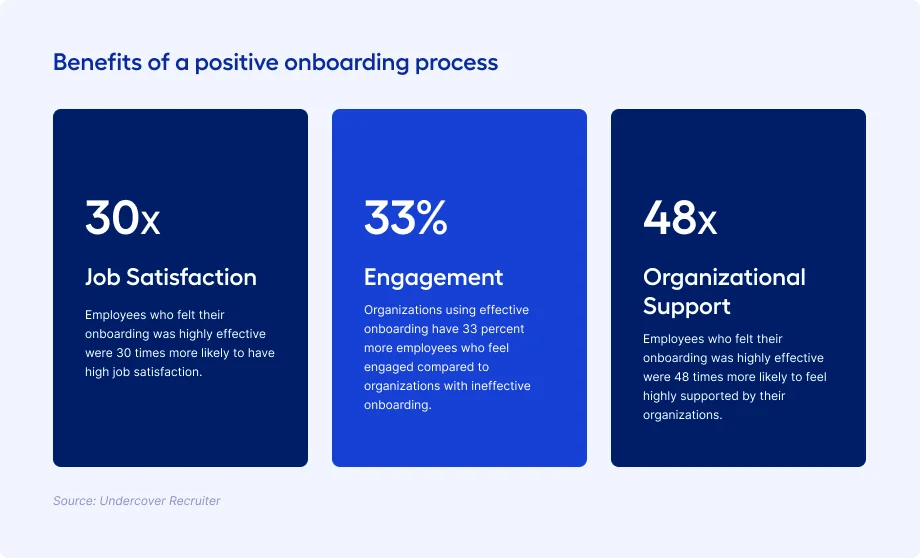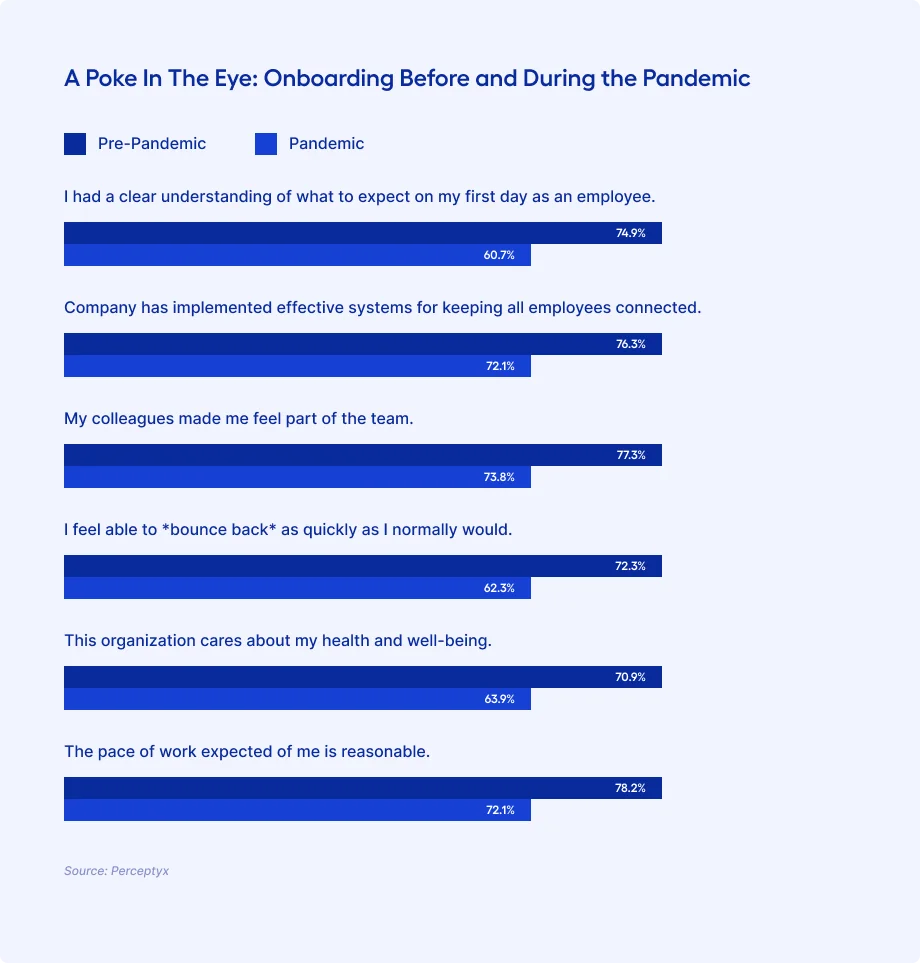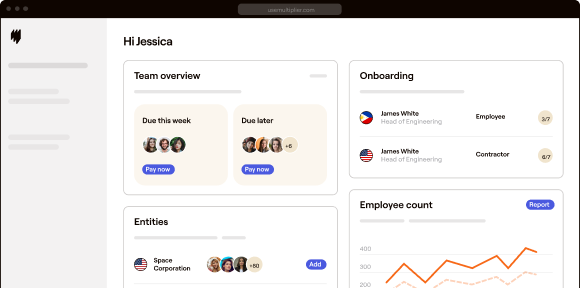The average onboarding process involves approximately 54 activities that are expected to be completed by the employees, according to Sapling HR. Those processes are even more complex when you take distributed and remote teams into the fray.
Virtual onboarding has become a mainstream tool in almost every organization as companies continue to hire remotely. Sadly, however, not all are as effective.
Onboarding is usually a one-time exercise that helps imprint an organization’s important values and cultural traits. A bad onboarding experience might leave new employees not feeling at one with the company.
New hires need an extra layer of value and engagement to connect better with the company, especially in the remote and distributed work era. They need to know their responsibilities, whom they are expected to work with, what they can expect from the organization, and what is expected of them. They also must have the right resources, know the right people to talk to, and be part of the company culture from the get-go. This creates a frictionless and seamless experience that enables better alignment with the organization and an easier route to productivity.
The Psychology Behind a Positive Onboarding—Satisfaction, Engagement, and Support
Virtual onboarding places greater emphasis on engagement and execution because the tools to gauge the mood, enhance interest, and increase participation are either too complex, costly, impractical, unavailable, or worse – deprioritized.
As Jamie Kohn from Garter puts it, this results in a crisis of connection.
“Employees today are experiencing a crisis of connection, and HR leaders report that the biggest challenge with expanding remote work is maintaining the organization’s culture.
“Traditionally, new hires connected to organizational culture organically by living it in their day-to-day, in-person interactions. For many people working remotely, changing companies can feel like swapping out one laptop for another,” says Kohn.
Building and maintaining social connections in the virtual world is a question not many companies answer. Is knowledge transfer happening effectively? Are new hires able to ask questions and clear their doubts without hindrance? Are they able to form bonds that they carry into work?
Another important piece of the puzzle is equipping new joiners with the right hardware and tools from day one. Employees who are onboarded promptly on the first day are left waiting, sometimes for weeks, to receive new laptops, devices, or virtual logins to realize their responsibilities effectively.
Companies must go the extra mile to ensure their employees don’t feel invisible or isolated. And they have only one chance at it.
How to Get Onboarding First-Time Right for Global Teams
Stop treating onboarding as a one-time event
Onboarding events are usually cram-all-you-can ones that, once completed, are hardly revisited. For the employee, the information shared usually becomes stale and is only internalized when they need it later. Companies need to take a phased manner to onboarding, allowing the employee to experience, learn and understand company culture, processes, and individual responsibilities.
Always stop to ask for feedback and get different stakeholders to engage with the employee.
Create a framework for a global onboarding process
Onboarding is a world away from orientation, so stop looking at form filling, document collection, and regulation awareness as part of your onboarding.
Companies must look beyond siloed onboarding experiences and create a unified plan with one base. A centralized source for valuable data, documentation, and answers should be a key part of the process.
Feedback collected from new hires should inform every subsequent onboarding event. Moreover, defined metrics should be established to measure, track and improve the efficacy of such programs.
Automate processes and make them less time-consuming
Automation is a gift that keeps on giving. By taking the robot out of the human, companies can leverage the time saved to create more engagement and meaning in the onboarding process. Automation can take care of mundane and tepid tasks such as filling out forms and submitting documents for necessary background checks. It allows companies to build something for the employees.
You begin before they begin
Whether it is to collect the required information to help connect earlier with the team, starting early has definite benefits. Of course, this may not be possible in every situation and depends heavily on how willing the employee is.
It allows the company to save time on onboarding and establish strong ties with the employee. They can get a strong whiff of what the company is about and how they work, thanks to regular communication with their teammates.
It also helps ensure companies can retain the top talent they have finalized.
Build social capital – involve many members of your team
Often, onboarding is an HR-centric exercise with little personalization. Once the company onboarding is completed, employees find out what their work entails and who they will be working with.
By involving different team members to talk about various aspects of the company/department/team/work/culture during the onboarding process, employees get a detailed as well as a comprehensive view. This also helps them interact with different colleagues and build social capital.
Demonstrate ‘who’ you really want to be as a company
Ask yourself, do the employees really know who we are as a company, what we stand for, did they buy it, and will they turn into advocates? If the answers are yes, then your onboarding process needs little fixing.
But be wary of how the onboarding process can cause a negative first impression. For instance, a company that speaks about transparency as a value but does little to demonstrate it in its onboarding could hurt employees.
Likewise, a company that calls itself a tech leader can create an impression using advanced technology such as the Metaverse to boost its onboarding experience.
Make logistics and infrastructure seamless
This aspect of onboarding is often overlooked, but it is a key part of ensuring a seamless and happy start to a company.
An onboarding process can create all sorts of waves, but if an employee returns to find that they do not have the hardware to start work, the whole idea is defeated. For distributed and remote teams, the logistics involved in getting the hardware and tools in time is a major headache, even for major enterprises.
Companies can now leverage employers of record (EOR) to deliver laptops and essential items to new employees’ doorsteps at a click of a button, helping both the company and the individual save significant amounts of time and energy.
Modern companies need modern solutions; this is the same approach they need with onboarding. A bad onboarding experience can very well be a canary in a coalmine-like experience for the top talent you’re hoping to hire. In this scarring war for talent, that’s the last thing ambitious companies need.









